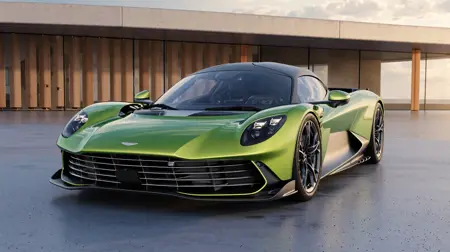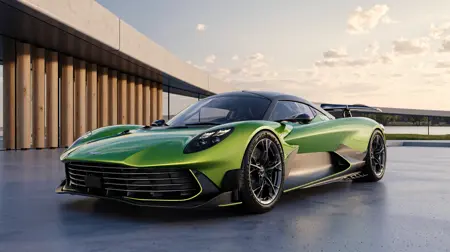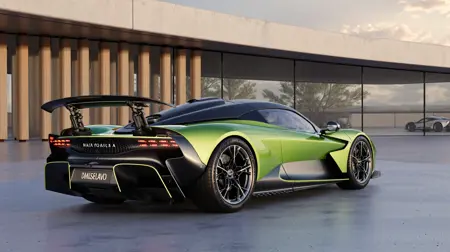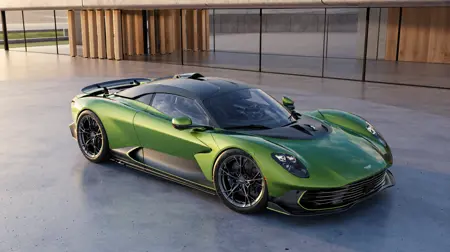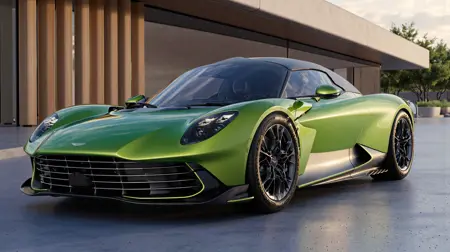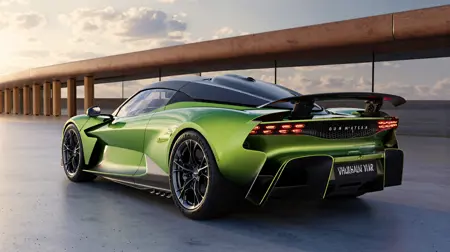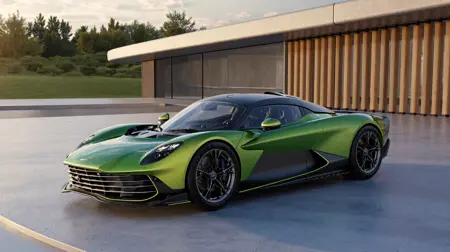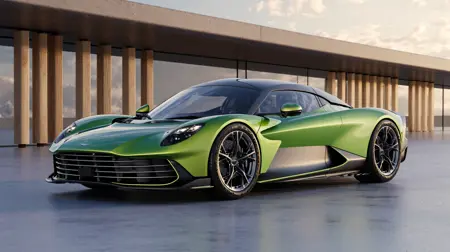Aston Martin Valhalla - 2025
세부 정보
파일 다운로드
이 버전에 대해
모델 설명
아스톤 마틴 발할라: 하이퍼카 왕조에 도전하는 F1 기술이 담긴 영국의 초고성능 슈퍼카
2025년 아스톤 마틴 발할라는 오랜 역사를 지닌 영국 자동차 브랜드에게 전환점이 되는 모델로, 브랜드 최초의 시리즈 생산 중앙엔진 플러그인 하이브리드 슈퍼카다. 단 999대만 생산되는 발할라는 단순한 신모델을 넘어, 브랜드 인식을 근본적으로 재정의하기 위해 설계된 기술적 ‘하로(Halo)’ 차량이다. 이 차량은 놀라운 성능 데이터를 자랑한다: 총 출력 1,064마력, 811lb-ft의 토크로 0-62마일/시간 가속을 단 2.5초에 달성하며 최고 속도는 217마일/시간에 이른다. 이 수치들보다 더 중요한 것은, 발할라가 아스톤 마틴의 새로운 시대에 대한 대담한 시도이며, 자동차 세계 최고 수준에서의 실행력을 증명하기 위한 고위험 투자라는 점이다.
이 차량의 개발 과정은 아스톤 마틴 자체의 기업적 변혁과도 일치한다. 2019년 처음 공개된 AM-RB 003 컨셉, 즉 “발퀴리의 아들”은 독자 개발한 3.0리터 트윈터보 V6 엔진을 중심으로 한 야심 찬 프로젝트였다. 이 전략은 파워트레인 독립을 목표로 했으나, 위험과 비용이 너무 크다고 판단되어 폐기되었다. 새 임원진 하에 회사는 실용적인 전환을 결정, 기술 파트너 메르세데스-AMG에서 유래한 고도로 수정된 4.0리터 트윈터보 V8 엔진을 채택했다. 이 결정은 엔지니어링 순수성이라는 내러티브를 포기하고, 검증된 세계 최고 수준의 엔진을 사용해 회사의 회생을 위한 핵심 차량을 성공적으로 구현하는 길을 선택한 것이었다.
결과적으로 도출된 기술 구조는 아스톤 마틴 퍼포먼스 테크놀로지스(AMPT) 컨설팅 그룹과의 긴밀한 협업을 통해 도출된 로드카 엔지니어링과 F1 기술의 뛰어난 융합체다. 아스톤 마틴 역사상 가장 강력한 별도 개발된 평면 크랭크 V8 엔진은 단독으로 817마력을 발생한다. 이는 400V 하이브리드 시스템과 세 개의 전기 모터로 보완된다—앞축을 구동하는 두 개의 모터와 완전히 새롭게 설계된 8단 듀얼 클러치 트랜스미션에 통합된 세 번째 모터다. 이 구조는 전기식 모든 휠 드라이브를 가능하게 해, 토크 벡터링을 통해 우수한 코너링 그립을 제공하며, 터보 레이그를 완전히 제거하는 ‘토크 필’ 기능과 약 9마일의 전기 전용 주행 가능 거리를 실현한다.
이 방대한 동력은 모터스포츠에서 직접 유래한 차체 및 공기역학 패키지로 제어된다. 기반은 경량화를 이루며 거대한 강성을 제공하는 전체 카본파이버 모노코크다. 전면 서스펜션은 F1 스타일의 푸시로드 시스템으로 불필요한 질량을 감소시키고 공기 흐름을 개선하며, 후면은 정교한 멀티링크 설계다. 발할라의 공기역학적 완성도는 F1과의 가장 명확한 연관성을 보여주며, 전후方に 완전히 활성화된 공기역학 시스템을 탑재한다. 레이싱 규정의 제약을 받지 않는 이 시스템은 다단계 리어 윙과 DRD(저항 감소 시스템)를 포함해 149mph에서 600kg(1,322lbs) 이상의 다운포스를 생성, 뛰어난 고속 안정성을 확보한다.
발할라는 기존의 V8 하이브리드 차량인 페라리 SF90 스트라 Dale와 람보르기니 레부엘토와 격렬한 경쟁을 벌이게 된다. 그러나 아스톤 마틴은 직접적인 지배권 다툼이 아니라 계산된 시장 파괴 전략을 실행 중이다. 예상 가격이 80만 달러에서 110만 달러 사이인 발할라는 이탈리아 경쟁 차량과 함께 마클렌 W1(210만 달러)과 페라리 F80(390만 달러)과 같은 신세대 하이퍼카와 동등한 성능을 제공하면서도 훨씬 접근 가능한 가격을 제시한다. 이 “가치 하이퍼카” 전략은 새로운 시장 니치를 창출하려는 의도적 시도다.
그러나 이 프로젝트는 심각한 도전에 직면해 있다. 생산 지연은 이미 기업의 이익 경고로 이어졌으며, 이처럼 복잡한 차량을 산업화하는 어려움을 보여준다. 또한 초기 프로토타입 평가는 차체 역학과 놀라운 실용성에는 만장일치로 찬사를 보냈지만, 핵심 우려 사항을 제기했다: V8 엔진의 조용한 사운드다. 감정과 감각적 드라마에 기반한 이 세그먼트에서, 음향적으로 부족한 하이퍼카는 기술적으로 뛰어나지만 정서적으로 공허하다는 인상을 줄 위험이 있다.
결국, 발할라의 유산은 아스톤 마틴이 이 마지막 장벽을 극복할 수 있는지에 달려 있다. 그 성공은 단순한 사양표상의 강력한 성능뿐 아니라, 완벽한 생산 확대, 시장의 파괴적 포지셔닝에 대한 반응, 그리고 최종 차량이 운전자의 감각뿐 아니라 청각에도 동일한 흥분을 전달할 수 있는지 여부에 의해 측정될 것이다. 만약 성공한다면, 발할라는 단순한 상업적 승리에 그치지 않고, 아스톤 마틴을 새로운 세대를 위한 새로운 브랜드로 재정의하게 될 것이다.
